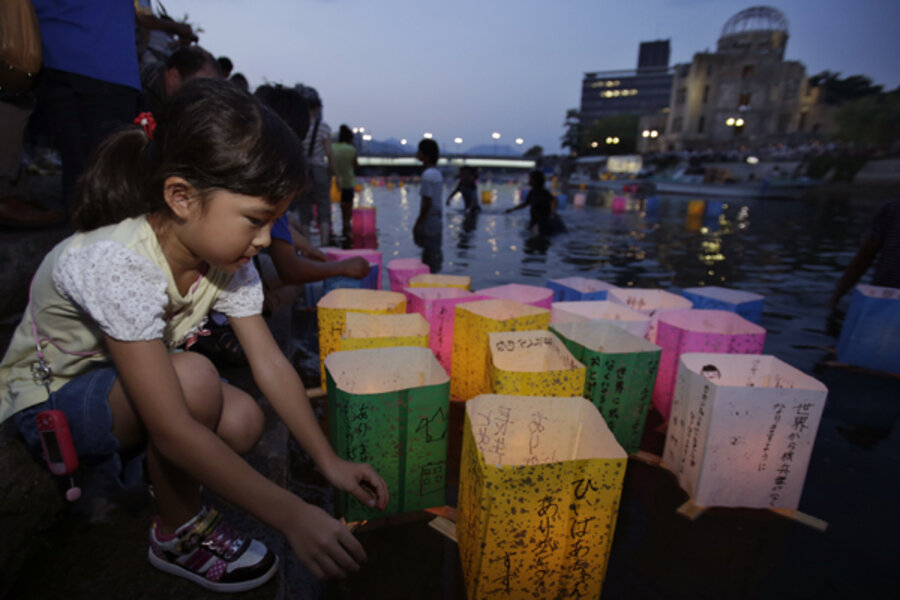Hiroshima marks atom-bomb anniversary as Japan unveils warship
Loading...
| Tokyo
As 50,000 people marked the 68th anniversary of the atomic bombing of Hiroshima, the mayor of the city used his speech at the somber annual ceremony to criticize Tokyo's plans to both restart the country’s nuclear reactors and export the technology.
A peace bell was struck at 8:15 a.m. on Tuesday, the moment the ‘Little Boy’ bomb was dropped on Hiroshima from a Boeing B-29 Superfortress on Aug. 6, 1945. Shortly afterward, Prime Minister Shinzo Abe spoke of the horrors of the attack and its aftermath.
“On this very morning 68 years ago, a single bomb deprived many more than 100,000 people of their precious lives,” said Mr. Abe. “Those who survived were forced to endure unspeakable hardships of illness and disability and tribulations in their daily lives.
“I swear I will do everything in my power to make peace a lasting reality and abolish nuclear weapons,” he added.
Hiroshima's mayor is critical
In the traditional peace declaration speech delivered every year by the mayor of Hiroshima, however, Mayor Kazumi Matsui rebuked the Abe administration over its intention to sell Japanese nuclear power technology to India, one of four countries that have not signed the Treaty on the Non-Proliferation of Nuclear Weapons.
“The government’s ongoing negotiations may bring economic benefits to Japan and India, but they will hamper efforts to eliminate nuclear weapons,” said Mr. Matsui.
The mayor went on to criticize the Abe administration’s plans to examine the restarting of Japan’s nuclear reactors, almost all of which have been taken offline since the triple meltdowns at the Fukushima Daiichi Nuclear Power Plant in March 2011. Approximately 100,000 people remain displaced by the disaster, and the plant’s operator, Tokyo Electric Power Co., or TEPCO, recently admitted that huge quantities of radioactive materials have been leaking continuously into the ocean since accident occurred.
“The people of Hiroshima know well the ordeal of recovery,” Matsui said. “We urge the national government to rapidly develop and implement a responsible energy policy that places top priority on safety and the livelihoods of the people.”
Memories fading
The politicians' remarks come, however, come as the history of the bombing of Hiroshima and, three days later, Nagasaki, feels increasingly remote to many Japanese. Japan still has more than 200,000 hibakusha, as the survivors of the atomic bombings are known, but their average age is almost 79; some worry that memories of the horrors of war may be fading with them.
Seven decades after World War II, the government is considering revisions to Japan’s pacifist Constitution, Article 9 of which states that "the Japanese people forever renounce war as a sovereign right of the nation and the threat or use of force as means of settling international disputes."
Japan is also considering changing the status of the mostly passive standing Army or Self-Defense Force, and allowing domestic weapons manufacturers to begin exporting. Japan also unveiled its largest postwar warship on Tuesday, the Izumo, stating that it will serve in a defense capacity and allow the country to quickly move people and supplies in response to major natural disasters.
William H. Saito, a Japanese-American entrepreneur who has been based in Tokyo for the past decade and served as chief technology officer on the Fukushima Nuclear Accident Independent Investigation Commission, visited Hiroshima Peace Park this week for the first time.
“I noticed the amount of explaining parents [in the Hiroshima Peace Memorial Museum] had to do to their kids about the history around the atomic bombing. That may be indicative of an educational issue regarding these events,” says Mr. Saito. “Though, the children were at least listening intently to what they were being told.”
For Saito, the visit to Hiroshima was a reminder of Japan's devastating history with nuclear weapons and power.
“Japan has been pretty unlucky," he says, "in the way it has had to experience nuclear: Hiroshima, Nagasaki and then Fukushima.”







